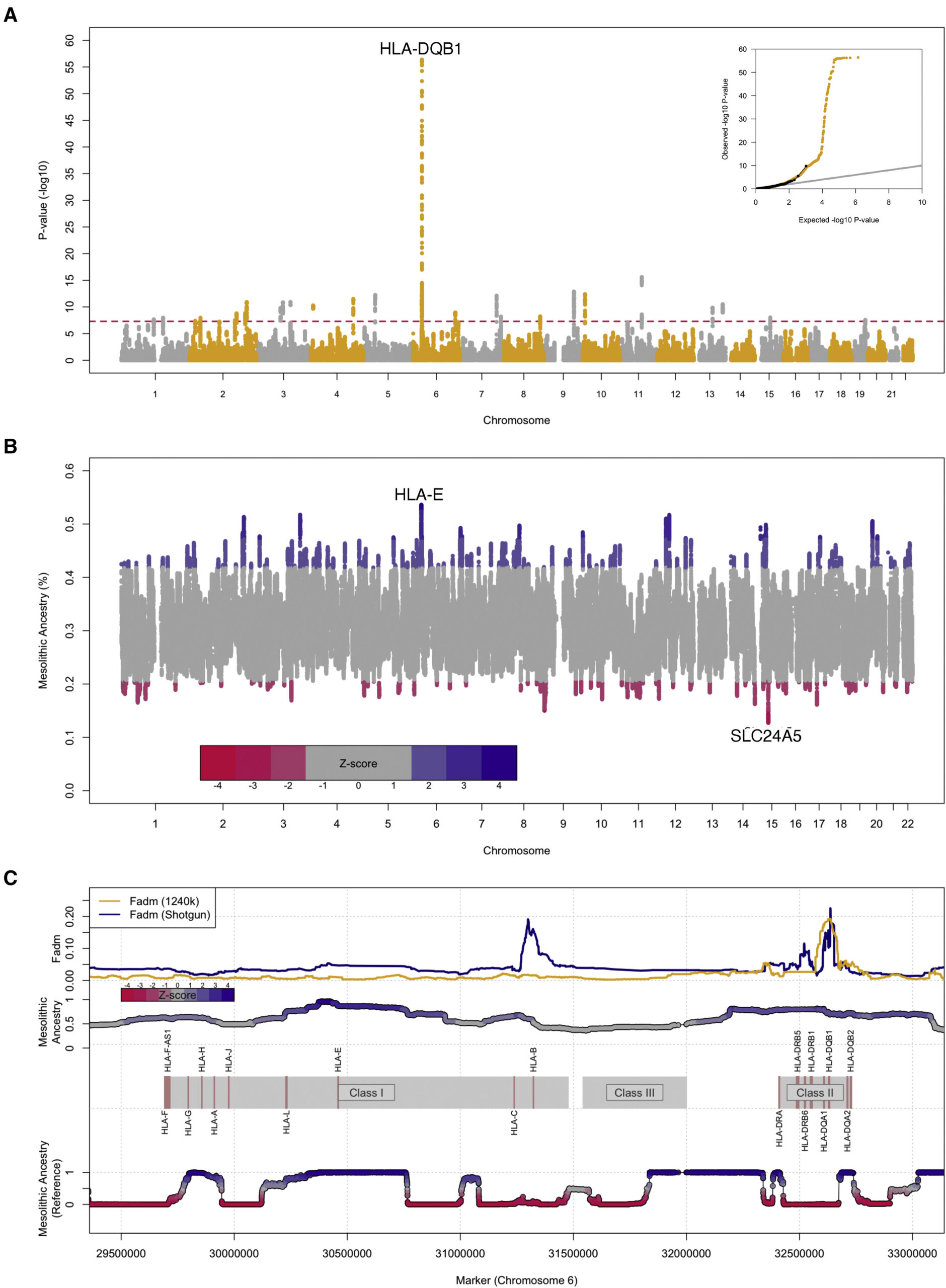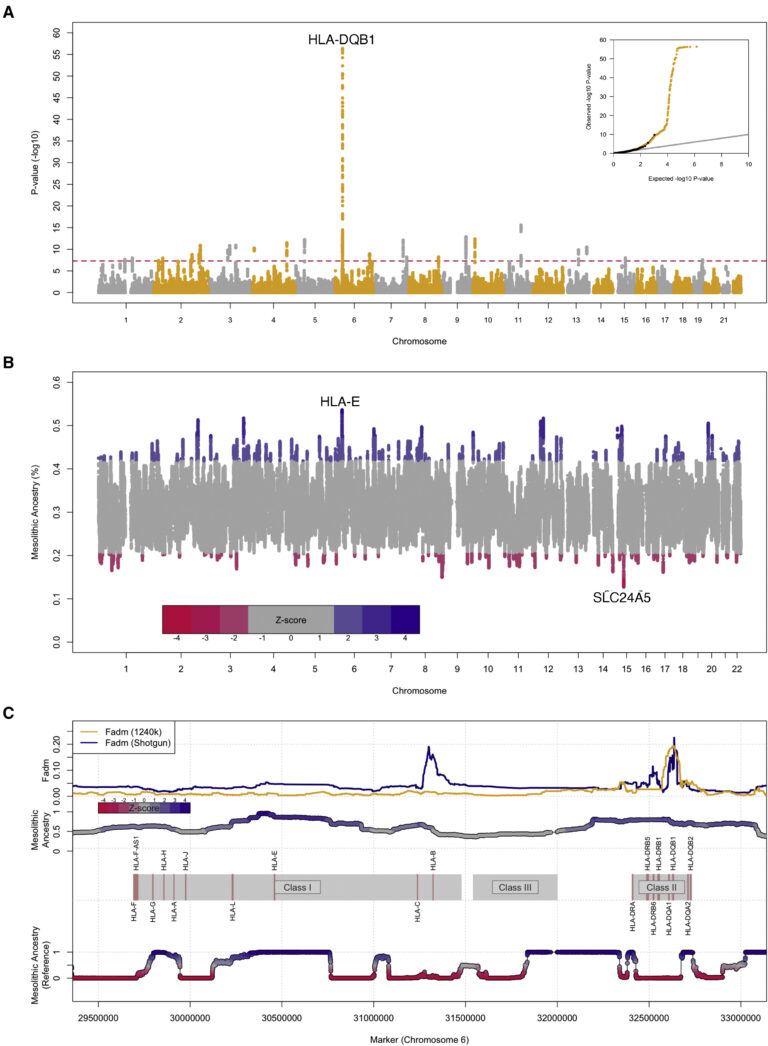
The findings, reported in Current Biology on March 23, suggest that mixing between the two groups resulted in mosaics of genetic variation that were acted upon by natural selection, a process through which all organisms, including humans, adapt and change over time.
The changes in immunity genes appeared in the major histocompatibility complex (MHC) region, a cluster of genes that code for surface proteins on cells and help our immune systems recognize pathogens. The researchers also detected more farmer ancestry in a gene called SLC24A5 , which is involved in skin pigmentation.
“This tells us that these regions of the genome were experiencing natural selection,” said Tom Davy (@TomDavy_) of the Francis Crick Institute’s Ancient Genomics Laboratory in London. “The genetic variants predominantly carried by hunter-gatherers in the MHC region and by farmers in SLC25A5 increased in frequency in the descendant population.”
In recent years, the study of ancient genomes has allowed scientists to essentially travel back in time to trace the evolution of humans and other organisms. Whereas most ancient DNA studies have focused on archaeological questions, Davy and Pontus Skoglund at the Francis Crick Institute and Iain Mathieson and colleagues of the University of Pennsylvania realized that the increasing availability of standardized and shared ancient genome data now allows new questions about natural selection and human adaptation in prehistoric times.
They analyzed genome-wide DNA from 677 individuals spanning Mesolithic and Neolithic Europe. Their goal was to look for any ancestry deviations in the genomes of admixed individuals and to test whether those deviations appeared to be the result of natural selection, as opposed to random changes.
Their analysis found that a pigmentation-associated gene was the most overrepresented from the Neolithic local ancestry. In contrast, the mixed group retained more genes from the important MHC immunity locus from the hunter-gatherers. The findings could simply reflect the advantage of having more diversity in immune response, the researchers say. On the other hand, the MHC alleles from the hunter-gatherers might have been positively selected for because they facilitated greater survival and adaptation to pathogens in the Neolithic group.
Although other factors may have been at play, the findings highlight immune function as a prime target of natural selection in late-Stone-Age populations. The researchers say the increased immune representation from hunter-gatherers came as something of a surprise to them.
“A longstanding idea is that farming lifestyles drove immune adaptation due to denser settlements, new diets, and proximity to livestock,” Skoglund said. “When farming groups expanded from the Near East into Europe and mixed with local hunter-gatherers, the natural prediction would be that the farmers’ immunity genes would be best adapted to the farming lifestyle and thus selected for. However, we see the opposite, that hunter-gatherer ancestry is enriched at the MHC immunity locus. This could, for example, be because the hunter-gatherers were already adapted to pathogens found in Europe, or it could be the result of natural selection favoring diversity in immunity genes.”
As for changes in pigmentation, earlier studies also had shown selection for reasons that aren’t fully understood.
“One hypothesis is that lighter skin pigmentation allowed farmers to synthesize more vitamin D from ultraviolet radiation, while hunter-gatherers were able to obtain sufficient vitamin D from their diet,” Mathieson says.
Overall, the new study extends recent findings of adaptive admixture at the MHC region to selection in a Stone Age human population for the first time. The researchers say the discovery of greater diversity at the MHC locus opens new avenues for understanding the adaptations that came along with the shift to an agricultural lifestyle, which the researchers note was a fundamental transition that happened worldwide in human history.
“This study revealed natural selection during the agricultural transition in one region of the world, Europe, but other regions are not well understood,” Skoglund said. “Future ancient-DNA studies will also be able to address to what extent immunity was a key target also in other periods of environmental and lifestyle change during human evolution.”
####
This work was supported by the NIGMS; the EMBO Young Investigator Programme; the Vallee Foundation; the European Research Council; the Wellcome Trust; and Francis Crick Institute core funding from Cancer Research UK, the UK Medical Research Council, and the Wellcome Trust.
Current Biology, Davy et al.: “Hunter-gatherer admixture facilitated natural selection in Neolithic European farmers” https://www.cell.com/current-
DOI: http://dx.doi.org/10.1016/j.
Press release from Cell Press.
Ancient genomes reveal immunity adaptation in early farmers
Research from the Francis Crick Institute published today in Current Biology has revealed that diversity in genes coding for immunity may have facilitated adaptation to farming lifestyles in prehistoric periods.
Researchers at the Ancient Genomics Laboratory at the Crick studied available genome-wide DNA from 677 individuals dating to Stone Age Europe, spanning the movement of Neolithic farmers from the Near East into Europe about 8000 years ago, where they mixed with Mesolithic hunter-gatherers already in Europe.
They were interested in whether any particular genes might have coded for adaptations important to early farming groups, and looked for evidence of rapid evolution in these populations.
Since about 20% of the ancestry of descendant late Stone Age people could be traced to the local European hunter-gatherers, the researchers also asked whether any particular genes showed evidence of more hunter-gatherer ancestry.
They found that a large genetic region responsible for immune responses to diseases – the major histocompatibility complex (MHC) – showed both the strongest evidence of rapid evolution, and more Mesolithic hunter-gatherer ancestry than expected, suggesting that genetic variants in the MHC region already present in Europe were passed down preferentially.
It has previously been thought that the transition to farming was associated with increased natural selection on immunity variants, as people started living closer to animals and eating more animal products. This research supports this view, but also shows that diversity in immune genes may be just as important as adaptation to lifestyle.
The research team speculates that either the hunter-gatherers already had genetic adaptations against bacteria, viruses or other microorganisms in Europe, or that having many different forms of the genes was advantageous.
Tom Davy, PhD student at the Francis Crick Institute and lead author, said: “It was really exciting to see for the first time that immunity is important for the transition to farming in a prehistoric population. The later Neolithic people had far more farmer ancestry in general, so we expected to see the same at the MHC region, especially as many diseases have been linked to Neolithic periods. But we saw about 50:50 ancestry from Neolithic farmers and Mesolithic hunter-gatherers here, showing that natural selection favoured genes from the hunter-gatherers already in Europe.
“At the moment we’re not quite sure why this happened, but a proposal is that the European hunter-gatherers had genetic variations which allowed them to fight Europe-specific diseases. Or picking up a variety of genes from both hunter-gatherers and farmers was beneficial because it resulted in lots of diversity at this major group of genes, allowing people to better fight off disease.”
The team also confirmed results from previous studies, showing that genes coding for skin pigmentation showed the greatest representation for Neolithic farmer ancestry, with these variations coming into Europe from the Near East. This may be to maintain vitamin D levels when sources, such as diet and exposure to sunlight, change.
Pontus Skoglund, Group Leader of the Ancient Genomics Laboratory at the Crick, said: “The shift to farming was an important transition all over the world, resulting in changing diets and exposure to infectious disease.
“Previous research has suggested that adaptation in genetic regions relating to immunity, such as the MHC, has been important in recent time periods, and this research now provides similar evidence for adaptation in prehistory. By growing the ancient genomic record, we will be able to better understand the role of immunity in other periods of the human past.”
Press release from the Francis Crick Institute.



